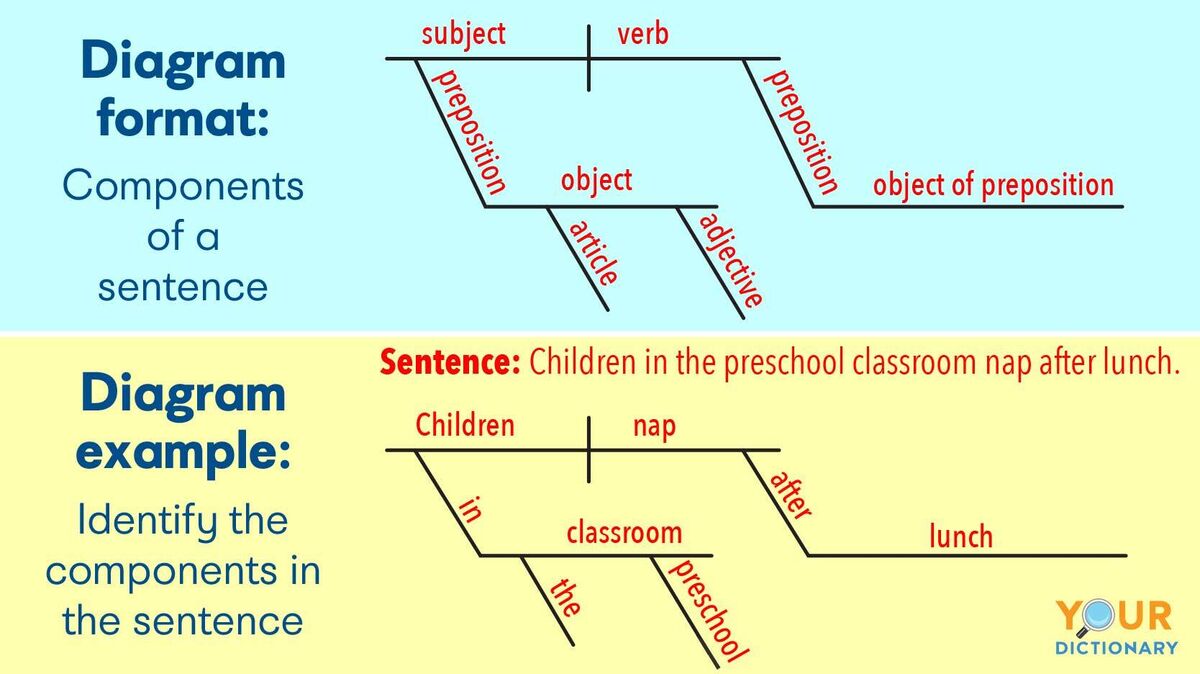
When you diagram sentences, you identify the sentence’s different parts of speech and how they work together. Even the simplest of sentences must have a subject and a verb, and grammatical rules dictate how the subject and verb interact. Keep reading to learn how to diagram a sentence and why diagramming sentences can give you a deeper understanding of the English language.
Components of Sentences
Sentences contain a number of different components, or parts, that must work together. Diagramming sentences allows you to separate and identify these different components of sentences by arranging them pictorially.
Although there are several methods of diagramming a sentence, each involves separating the subject, the predicate (the verb) and the other components of a sentence.
Those components can include:
- subject – who or what the sentence is about; the noun doing the action
- predicate – verb or action being done
- direct object – something/someone the action is done to
- indirect object – the person/thing the action is done to or for
- prepositions – relationship words that provide information about how the other parts of the sentence fit together
- modifiers – words that provide additional detail about a subject, action or object in the sentence
- articles – words that modify nouns
- dependent (subordinate) clauses – clauses that can't stand alone
- conjunctions – words that connect other words together
Diagramming sentences helps you identify how the parts of a sentence work together. It provides a deeper understanding of the function that words play in sentences. This can help make your own writing clearer and free of grammatical errors.
How to Diagram a Sentence
Now that you know the parts of a sentence, you’re ready to start diagramming! There are four types of lines you’ll need for sentence diagramming:
- horizontal lines (⎯⎯⎯) to write subjects, verbs and objects
- vertical lines ( | ) to separate subjects, verbs and objects
- diagonal lines ( / ) to write modifiers, prepositions and articles
- dotted vertical or diagonal lines ( ⦙ ) for conjunctions
Plan out your diagrammed sentence by finding the most important words – the subject and the verb – and continuing from there. Follow these simple steps to properly diagram any sentence.
The Baseline
The baseline is the top line of your diagram. It highlights the fundamental pieces of the sentence: the subject, verb and object.
- Draw a baseline (the top line of your diagram) separated by a short vertical line.
- Write the subject on the left side and the verb on the right side.
- If there is an object, add it after the verb with a diagonal line.
Below the Baseline
Each of the other components of the sentence belong below the baseline of the sentence, according to specific sentence diagramming rules. These parts include modifiers, prepositions, indirect objects, subordinate clauses, articles, interjections, and so on.
- Write modifiers and prepositions on diagonal lines extending from the word they modify under the baseline.
- The object of the preposition goes on a horizontal line under the preposition.
- If there is an indirect object, write it on a horizontal line under the verb and connect it with a diagonal line.
- Add articles on diagonal lines under the nouns they modify.
Complex Sentence Additions
If your complex sentence has a subordinate clause as well as an independent clause, you’ll need to diagram it as well. Subordinate clauses are treated like modifiers joined by conjunctions in sentence diagrams.
- Write the subordinating conjunction on a diagonal dotted line under the word it modifies.
- Draw a horizontal line under the dotted line.
- Add the noun, verb and object on the horizontal line, separated by vertical lines.
- Draw solid diagonal lines under any words that have modifiers, and add the modifiers to their words.
Compound Sentence Additions
Compound sentences are made of two or more independent clauses. Each independent clause gets its own separate diagram, with its own separate baseline for its subject and verb.
- Create a new baseline under the first diagrammed clause.
- Start from the beginning: add the second clause’s subject, verb, object, and other parts.
- When you’ve diagrammed all clauses, join the clauses with dotted lines.
- Write the coordinating conjunction on a horizontal line next to the dotted line.
Purpose of Diagramming Sentences
There are a number of different reasons diagramming sentences can be useful, all of which are related to developing a deeper understanding of English grammar. Diagramming sentences can help you to:
- learn and identify the parts of speech
- understand how the parts of speech function together to create compound sentences
- explore methods of joining subjects, verbs and objects
- understand complex grammatical tools used to make compound sentences, including prepositional phrases, verbal nouns, modifiers and compound subjects
If you’re writing a sentence and something doesn’t sound quite right, try diagramming it. You may find that your modifiers are too far from their modified words, you’re missing an article, or your sentence is a fragment. Diagramming sentences is a great way to clear up common grammatical errors in your writing.
Examples of Diagramming Sentences
Diagramming sentences is a straightforward way to examine your own grammar, but getting the hang of it can be a little tricky. The easiest way to understand sentence diagramming is to study sentences that have been diagrammed and to practice diagramming your own. For more sentence diagramming practice, check out these engaging diagramming worksheets.